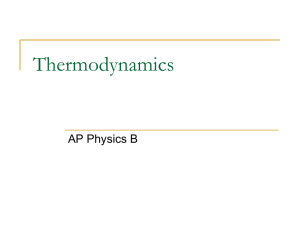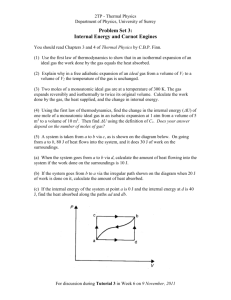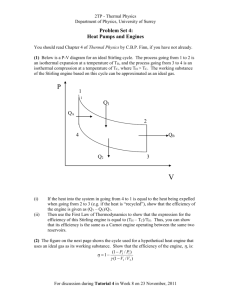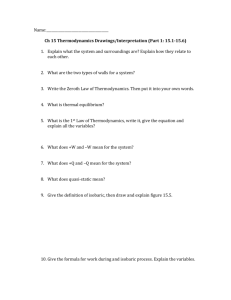Physics 262/266 George Mason University Prof. Paul So
advertisement
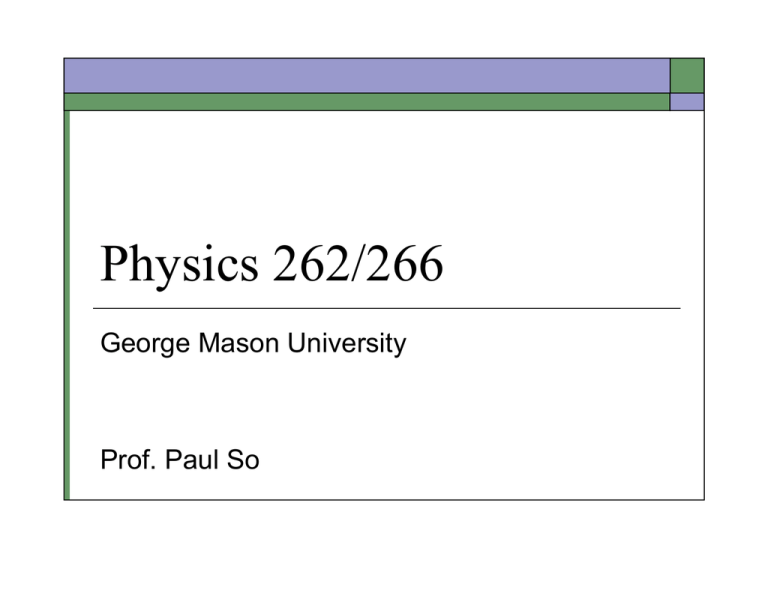
Physics 262/266 George Mason University Prof. Paul So Chapter 20: The 2nd Law of Thermodynamics Preferential Direction in Thermodynamic Processes Heat Engine and Efficiency The 2nd Law of Thermodynamics The Carnot Cycle (the most efficient heat engine) Entropy Entropy and Disorder Preferred Direction of Natural Processes Processes not observed in nature: Example 1: Ball absorbing heat energy from surrounding Then, converts it into mechanical energy and starts to bounce and roll Note: energy is conserved (1st Law is NOT violated): heat mechanical eng. BUT, we don’t observe this process in nature while the reverse occurs! Preferred Direction of Natural Processes Example 2: cold Q hot Two objects are in thermal contact and heat flows from the cold object to the hot object. Again, energy is conserved (1st Law is NOT violated): Qhot (absorbed ) Qcold (release) 0 BUT, we don’t observe this process in nature while the reverse occurs! Disorder and Thermodynamic Processes The 2nd Law of Thermodynamics is the physical principle which will delineate the preferred direction of natural processes. We will also see that The preferred direction of natural processes The degree of randomness (disorder) of the resulting state All natural processes in isolation will tend toward a state with a larger degree of disorder ! The 2nd Law of Thermodynamics Historically, there are more than one but equivalent way to state the 2nd Law: To address the condition in example #2, here is the Clausius Statement on the 2nd Law: cold Q hot “It is impossible for any process to have as its sole result the transfer of heat from a cooler to a hotter body.” The 2nd Law of Thermodynamics There is also the Kelvin-Planck’s Statement: “It is impossible for any system to undergo a cyclic process in which it absorbs heat from a reservoir at a given temperature and converts the heat completely into mechanical work.” This implies that all heat engines have limited efficiency ! (efficiency of real mechanical engines ~ 15 to 40%) To understand this form of the 2nd Law, we need to look at a toy model: heat engine Heat Engines Definition: A device that converts a given amount of heat into mechanical energy. All heat engines carry some working substance thru a cyclic process: Engine absorbs heat from hot reservoir at TH Mechanical work is done by engine Engine releases residual heat to cold reservoir at TC Dstering Work Done by an Heat Engine The engine works in a cyclic process, U 0 1st Law gives, U Qnet W 0 Qnet W where, Qnet QH QC QH QC explicit signs for heats Efficiency for a Heat Engine Thermal Efficiency e is defined as the ratio of the mechanical energy output to the heat energy input, W what you get out e QH what you put in Substituting W QH QC , we have e using explicit signs here Q Q W QH QC 1 C 1 C QH QH QH QH A “perfect” (100% efficient) heat engine |QH| A “perfect” heat engine means 100% efficiency (e=1). This means that QC e 1 1 means QC 0 QH All heat absorbed from reservoir TH is converted into mechanical work W. No residual heat is released back. e perfect 1 The Kelvin-Planck’s statement of the 2nd Law does not allow this ! erealistic 1 Ddrinking bird 2nd Law, Disorder, & Available Energy Two Forms of Energy in any Thermal Process: Internal Energy Macroscopic Mechanical Energy In the Kinetic-Molecular Model, this consists of the KE and PE associated with all the randomly moving microscopic molecules. The piston’s motion in an automobile engine results from the coordinated macroscopic motion of the molecules. (One typically cannot control the individual random motions of all these molecules.) (Energy associated with this coordinated [ordered] motion can be used for useful work.) 2nd Law, Disorder, & Available Energy In a natural process (a block sliding to a stop), stopped e.g. v f slightly warmer due to friction The coordinated motion of the block is converted into the KE & PE of the slightly more agitated random motions of the molecules in the block/table. Macroscopic Mechanical Energy (KE of the block) is converted into Internal Energy through heat as a result of friction. 2nd Law, Disorder, & Available Energy Now consider the reverse situation… it is unlikely that one can coordinate ALL the randomly moving molecules in a concerted fashion. In other words, one typically cannot convert the internal energy of a system completely back into macroscopic mechanical energy. However, this does not mean that internal energy is not accessible. An Heat Engine is exactly the machine that can perform this conversion but only partially. The 2nd Law of Thermodynamics is basically a statement limiting the availability of internal energy for useful mechanical work. The Carnot Cycle (The Most Efficient Heat Engine) A reversible cycle described by Sadi Carnot in 1824. The Carnot Theorem gives the theoretical limit to the thermal efficiency of any heat engine. The Carnot cycle consists of: A cycle operating between two temperatures: TH and TC 2 reversible isothermal processes in which Q 2 reversible adiabatic processes in which TH TC An Ideal Gas as its working substance Steps of the Carnot Cycle animation http://galileoandeinstein.physics.virginia.edu/more_stuff/flashlets/carnot.htm Steps of the Carnot Cycle animation http://galileoandeinstein.physics.virginia.edu/more_stuff/flashlets/carnot.htm Details on the Carnot Cycle The isothermal expansion (ab) and compression (cd): U isothermal 0 (T is constant and U(T) is a function of T only for an Ideal Gas.) V QH Wab nRTH ln b Va (ab : isothermal expansion) QC Wcd Vd Vc nRTC ln nRTC ln (Vc Vd ) Vc Vd (cd : isothermal compression) Details on the Carnot Cycle The adiabatic expansion (bc) and compression (da): Qadiabatic 0 (by definition) From Section 19.8, we learned that TV 1 const for adiabatic processes. TH Vb 1 TCVc 1 (bc: adiabatic expansion) TH Va 1 TCVd 1 (da: adiabatic compression) Dividing these two equations gives, Vb Vc Va Vd Efficiency of the Carnot Cycle From definition, we have e 1 QC QH Using our results for QC and QH from the isothermal processes, nRTC ln Vc Vd TC ln Vc Vd e 1 1 nRTH ln Vb Va TH ln Vb Va From the adiabatic processes, we have Vb Va Vc Vd ln Vc Vd 1 ln Vb Va e 1 QC QH 1 TC (T must be in K) TH (Carnot Cycle only) Efficiency of the Carnot Cycle ecarnot TC 1 TH (Carnot Cycle) General Comments: Higher efficiency if either TC is lower and/or TH is higher. For any realistic thermal process, the cold reservoir is far above absolute zero and TC > 0. Thus, a realistic e is strictly less than 1! (No 100% efficient heat engine) Realistic heat engines must take in energy from the high T reservoir for the work that it produces AND some heat energy must be released back to the lower T reservoir. (Kelvin-Planck’s Statement) skip Internal Combustion Engine The Otto Cycle A fuel vapor can be compressed, then detonated to rebound the cylinder, doing useful work. animation http://auto.howstuffworks.com/engine1.htm The Otto Cycle intake intake exhaust ab b, c cd For the two constant V processes: 2 and 4, we can calculate, QH U 2 nCV (Tc Tb ) 0 QC U 4 nCV (Ta Td ) 0 r is the compression ratio (8 to 13) exhaust The Otto Cycle Applying the definition of efficiency, nCV Ta Td QC Ta Td e 1 1 1 QH nCV Tc Tb Tc Tb Now, we can utilize the two adiabatic processes: 1 and 3, TaVa 1 TbVb 1 Ta rV 1 TbV Ta r 1 Tb 1 and TcVc 1 TdVd 1 TcV 1 Td rV Tc Td r 1 1 The Otto Cycle Substituting Tb and Tc into the efficiency equation, we have, e 1 Ta Td Ta Td Ta Td 1 1 Tc Tb Td r 1 Ta r 1 Ta Td r 1 e 1 1 r 1 Using a typical value for the compression ratio r = 8 and = 1.40 gives, e 0.56 (or 56%) Note: This is a theoretical value. Realistic gasoline engine typically has e ~ 35%. The Diesel Cycle Key difference: No fuel in cylinder at the beginning of the compression stroke (process 1) Fuel is injected only moments before ignition in the power stroke No fuel until the end of the adiabatic compression can avoid pre-ignition Compression ratio r value can be higher (15 to 20) Higher temperature can be reached during the adiabatic compression Higher e and no need for spark plugs Dsteam engine Refrigerators Refrigerators are basically heat engine running in reverse. Heat from inside the refrigerator (cold T reservoir) is absorbed and released into the room (high T reservoir) with the input of mechanical work. Refrigerators From 1st Law, U cycle 0 QC QH W QH QC W explicit signs (Note: we have put in the explicit signs according to our sign convention.) |QC| (absorbed) positive |QH| (released) negative |W| (work is done on working substance by motor) negative Coefficient of Performance for a Refrigerator QC QC what you get K what you put in W QH QC A “perfect” Refrigerator K QC W QC QH QC A “perfect” refrigerator means ( K ). This means that QH QC or W 0 No mechanical work W is needed to transfer heat from the cold reservoir to the hot reservoir. The Clausius’s statement of the 2nd Law does not allow this ! K realistic Entropy Recall from a Carnot Cycle, we have derived the following relationship: QC T C QH TH QH QC 0 TH TC Formally, we can rewrite this as, Q 0 cycle T (We have absorbed the explicit sign back into the Q variable.) where Q represents the heat absorbed/released along the isotherm at temp T. Entropy Any reversible cycles can be approximated as a series of Carnot cycles ! Entropy This suggests that the following generalization to be true for any reversible processes, dQr T 0 cycle where, dQr is the infinitesimal heat absorbed/released by the system at an infinitesimal reversible step at temp T. cycle denotes the integration evaluated over one complete cycle.




